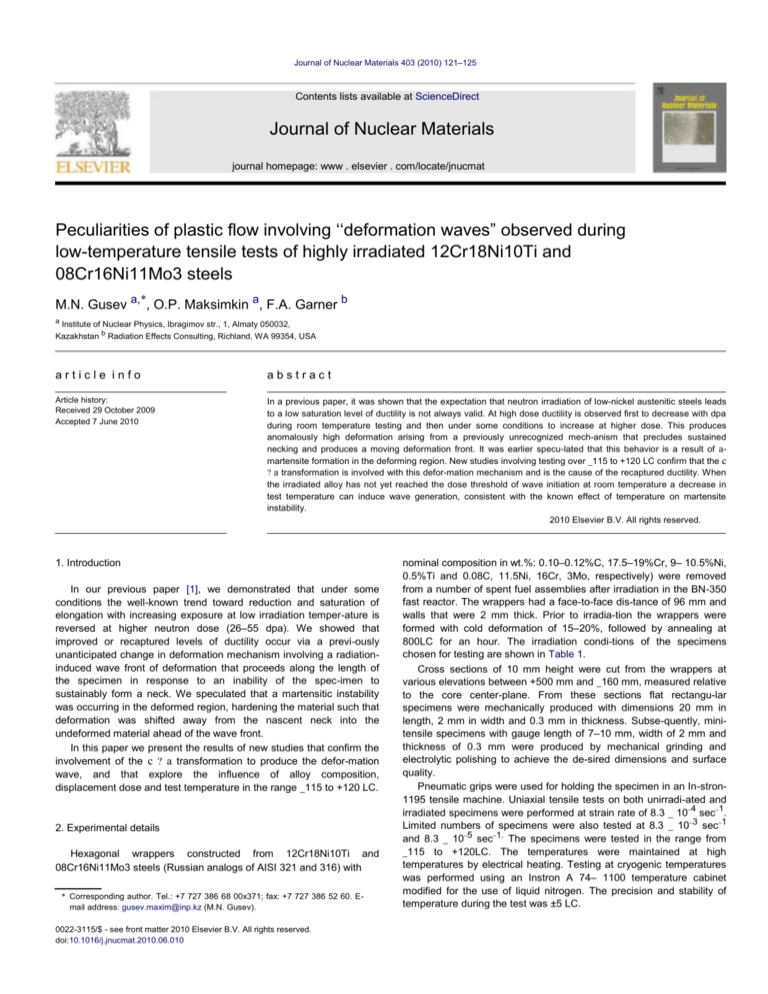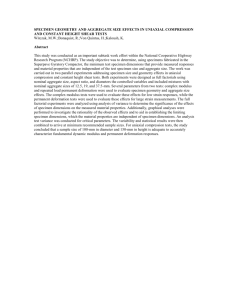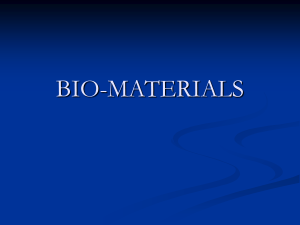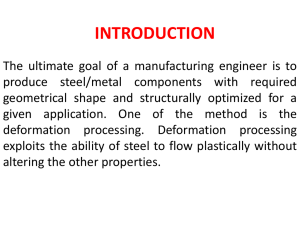
Journal of Nuclear Materials 403 (2010) 121–125
Contents lists available at ScienceDirect
Journal of Nuclear Materials
journal homepage: www . elsevier . com/locate/jnucmat
Peculiarities of plastic flow involving ‘‘deformation waves” observed during
low-temperature tensile tests of highly irradiated 12Cr18Ni10Ti and
08Cr16Ni11Mo3 steels
M.N. Gusev a,*, O.P. Maksimkin a, F.A. Garner b
a
Institute of Nuclear Physics, Ibragimov str., 1, Almaty 050032,
Kazakhstan b Radiation Effects Consulting, Richland, WA 99354, USA
article info
abstract
Article history:
Received 29 October 2009
Accepted 7 June 2010
In a previous paper, it was shown that the expectation that neutron irradiation of low-nickel austenitic steels leads
to a low saturation level of ductility is not always valid. At high dose ductility is observed first to decrease with dpa
during room temperature testing and then under some conditions to increase at higher dose. This produces
anomalously high deformation arising from a previously unrecognized mech-anism that precludes sustained
necking and produces a moving deformation front. It was earlier specu-lated that this behavior is a result of amartensite formation in the deforming region. New studies involving testing over _115 to +120 LC confirm that the c
? a transformation is involved with this defor-mation mechanism and is the cause of the recaptured ductility. When
the irradiated alloy has not yet reached the dose threshold of wave initiation at room temperature a decrease in
test temperature can induce wave generation, consistent with the known effect of temperature on martensite
instability.
2010 Elsevier B.V. All rights reserved.
1. Introduction
In our previous paper [1], we demonstrated that under some
conditions the well-known trend toward reduction and saturation of
elongation with increasing exposure at low irradiation temper-ature is
reversed at higher neutron dose (26–55 dpa). We showed that
improved or recaptured levels of ductility occur via a previ-ously
unanticipated change in deformation mechanism involving a radiationinduced wave front of deformation that proceeds along the length of
the specimen in response to an inability of the spec-imen to
sustainably form a neck. We speculated that a martensitic instability
was occurring in the deformed region, hardening the material such that
deformation was shifted away from the nascent neck into the
undeformed material ahead of the wave front.
In this paper we present the results of new studies that confirm the
involvement of the c ? a transformation to produce the defor-mation
wave, and that explore the influence of alloy composition,
displacement dose and test temperature in the range _115 to +120 LC.
2. Experimental details
Hexagonal wrappers constructed from 12Cr18Ni10Ti and
08Cr16Ni11Mo3 steels (Russian analogs of AISI 321 and 316) with
* Corresponding author. Tel.: +7 727 386 68 00x371; fax: +7 727 386 52 60. Email address: gusev.maxim@inp.kz (M.N. Gusev).
0022-3115/$ - see front matter 2010 Elsevier B.V. All rights reserved.
doi:10.1016/j.jnucmat.2010.06.010
nominal composition in wt.%: 0.10–0.12%C, 17.5–19%Cr, 9– 10.5%Ni,
0.5%Ti and 0.08C, 11.5Ni, 16Cr, 3Mo, respectively) were removed
from a number of spent fuel assemblies after irradiation in the BN-350
fast reactor. The wrappers had a face-to-face dis-tance of 96 mm and
walls that were 2 mm thick. Prior to irradia-tion the wrappers were
formed with cold deformation of 15–20%, followed by annealing at
800LC for an hour. The irradiation condi-tions of the specimens
chosen for testing are shown in Table 1.
Cross sections of 10 mm height were cut from the wrappers at
various elevations between +500 mm and _160 mm, measured relative
to the core center-plane. From these sections flat rectangu-lar
specimens were mechanically produced with dimensions 20 mm in
length, 2 mm in width and 0.3 mm in thickness. Subse-quently, minitensile specimens with gauge length of 7–10 mm, width of 2 mm and
thickness of 0.3 mm were produced by mechanical grinding and
electrolytic polishing to achieve the de-sired dimensions and surface
quality.
Pneumatic grips were used for holding the specimen in an In-stron1195 tensile machine. Uniaxial tensile tests on both unirradi-ated and
_
_
irradiated specimens were performed at strain rate of 8.3 _ 10 4 sec 1.
_3
_
Limited numbers of specimens were also tested at 8.3 _ 10 sec 1
_5
_1.
and 8.3 _ 10 sec The specimens were tested in the range from
_115 to +120LC. The temperatures were maintained at high
temperatures by electrical heating. Testing at cryogenic temperatures
was performed using an Instron A 74– 1100 temperature cabinet
modified for the use of liquid nitrogen. The precision and stability of
temperature during the test was ±5 LC.
122
M.N. Gusev et al. / Journal of Nuclear Materials 403 (2010) 121–125
Table 1
Position and irradiation conditions of investigated samples of 12Cr18Ni10Ti and
08Cr16Ni11Mo3.
Steel
Assembly
code
Distance from the
center of the core
Irradiation
temperature
(mm)
(LC)
Dose
(dpa)
12Cr18Ni10Ti
12Cr18Ni10Ti
12Cr18Ni10Ti
12Cr18Ni10Ti
08Cr16Ni11Mo3
08Cr16Ni11Mo3
H-42
CC-19
CC-19
H-214-1
B-300
B-337
_300
+500
_160
0
_500
_500
290
423
310
337
302
305
13
26
55
17
11
12
08Cr16Ni11Mo3
H-214(2)
_900
281
1.27
During tensile experiments a technique called ‘‘digital marker
extensometry” [2,3] was used. With this technique it is possible to
obtain the true stress–true strain behavior for a miniature spec-imen,
as well as to identify the localized deformation region and to trace its
evolving geometry during continuous deformation.
Video-recording was applied at all test temperatures, but for
cryogenic temperatures the resolution of the record is reduced because of the longer specimen to camera distance. Therefore the record at cryogenic temperatures is used primarily to establish whether a
moving deformation wave occurs or not. A combination of
magnetometry, metallography and microhardness measure-ments was
used to determine the existence, level and distribution of a-martensite.
The measurement of the amount of martensite was performed with
a Fisher-MP-30 ferroprobe. For translation from dimension-less ‘‘ferrite
numbers” to volumetric martensite amount a set of probes with known
amount of martensite were used as standards. The etalon probe set
was produced by using X-radiography and density measurements
according to Ref. [4]. Some etalons were fabricated from pure iron
powder as described in Ref. [5]. Aspects of etalon probe fabrication
and scale factors for sample thickness corrections are described in
detail in Ref. [6].
Fig. 1. Distribution of a0-martensite amount along the specimen length (12Cr18Ni10Ti,
26 dpa, deformed at 20 C). The deformation was interrupted when the wave had
reached the 4–5 mm position. Direction of wave movement is from right to the left.
3. Experimental results
Fig. 2. Engineering stress–strain curves for an unirradiated (ini) specimen of
12Cr18Ni10Ti and irradiated specimens; curve #1, 08Cr16Ni11Mo3, 11 dpa; #2,
08Cr16Ni11Mo3, 1.27 dpa; #3, 12Cr18Ni10Ti, dose 55 dpa; #4, 12Cr18Ni10Ti, 26 dpa.
All tests were conducted at 20 LC.
It was confirmed that when a moving wave form of deformation was
observed it was accompanied by a c ? a martensitic transfor-mation
has indeed occurred in the deformed area immediately be-hind the
wave front. While the amount of martensite in a deformed unirradiated
specimen averages about 5–10% in volume [4,7] the volume of
martensite behind the wave is 30–35% in a specimen irradiated to 26
dpa at 423 LC, as shown in Fig. 1. The stress–strain curve for this
specimen is designated as #4 in Fig. 2.
The measured values of strength and ductility at room temper-ature
are shown in Table 2 for different test temperatures and ap-plied strain
rates. In Fig. 2, it can be seen that the unirradiated steel is
characterized by high ductility and a high ability to strain-hard-en with
mation front that travels along the length of the specimen. In the 55
dpa specimen tested at 20 LC the wave front moved at _0.04 mm/s
while the applied strain rate to the specimen was only 0.008 mm/s,
reflecting a concentration of the deformation at the wave front. The
local deformation behind the wave front is usually in the 30–40%
range.
Sometimes these waves started near each grip and progressed in
opposite directions. Usually the second wave begins just after the first
wave stops. There was one example, however, where simultaneous
movement of two waves was observed. When two waves occurred,
this produced the highest total engineering defor-mation of 40–48%.
the ultimate stress rB significantly greater than the yield stress r02. As
the dose increases one can see that irradiation of 12Cr18Ni10Ti and
08Cr16Ni11M03 to doses of <20 dpa leads to substantial increases in
yield stress and reduction of ductility, a behavior consistent with that of
many previous studies [8–11]. A neck develops very quickly after the
yield point, quickly leading to localized failure while most of the
specimen does not participate in the deformation. At higher doses
however, the anomalous behavior asserts itself. Note that after a small
decrease in strength following yielding there is an extended plateau
without significant increase in load.
In the 26 or 55 dpa cases where anomalous ductility was ob-served
a stable immobile neck did not develop. The boundary of the localized
deformation band moves, producing a moving defor-
In most cases the wave front is defined by a simple straight line at
an angle of 45–50L to the deformation axis, but sometimes the wave
front exhibits a corner (intersection of two straight lines) that is
probably the result of two initiation sites occurring on opposite sides of
the specimen at nearly the same axial location (see Fig. 3a).
Specimens of 12Cr18Ni10Ti irradiated to 26 dpa were tested in the
_
_
_
interval 8.3 _ 10 3 to 8.3 _ 10 5 s 1. Since the martensitic
transformation is known to be sensitive to the speed of deforma-tion
one might expect the test speed to influence the occurrence of
deformation waves, primarily due to temperature rises associ-ated with
martensite formation and heat retention in larger spec-imens.
However, as shown in Table 2, a variation of deformation speed by
one order of magnitude did not lead to disappearance
M.N. Gusev et al. / Journal of Nuclear Materials 403 (2010) 121–125
123
Table 2
Mechanical properties of investigated samples.
Steel, assembly, level (mm)
Dose (dpa)
12Cr18Ni10Ti, unirradiated steel
12Cr18Ni10Ti, H-42, _300
12Cr18Ni10Ti, H-42, _300
12Cr18Ni10Ti, CC-19, +500
12Cr18Ni10Ti, CC-19,+500
12Cr18Ni10Ti, CC-19, +500
12Cr18Ni10Ti, H-214-1, 0
12Cr18Ni10Ti, H-214-1, 0
12Cr18Ni10Ti, CC-19, _160
12Cr18Ni10Ti, CC-19, +500
12Cr18Ni10Ti, CC-19, _160
08Cr16Ni11Mo3, H-214-2, _900
08Cr16Ni11Mo3, B-300, _500
08Cr16Ni11Mo3, B-300, _500
08Cr16Ni11Mo3, B-300, _500
–
13
13
26
26
26
17
17
55
26
55
1.27
11
11
11
08Cr16Ni11Mo3, B-300, _500
12
_
Strain rate (s 1)
eu (%)
eT (%)
Presence of wave
20
20
_40
20
20
20
20
_50
20
60
120
20
20
_40
_80
8.3 _ 10 4
_
8.3 _ 10 4
_
8.3 _ 10 4
_
8.3 _ 10 4
_
8.3 _ 10 3
_
8.3 _ 10 5
_
8.3 _ 10 4
_
8.3 _ 10 4
_
8.3 _ 10 4
_
8.3 _ 10 4
_
8.3 _ 10 4
_
8.3 _ 10 4
_
8.3 _ 10 4
_
8.3 _ 10 4
_
8.3 _ 10 4
200
860
1030
780
800
790
980
980
960
740
940
710
970
1200
1110
650
1010
1110
930
1030
950
1120
1120
1070
850
980
820
1100
1270
1270
65
3
_1
18
48
21
<2
2.0
20
40
_1
11
1.5
1.5
1
73
7
53
18.5
48
21.5
5
23
22
43
<4
13
4
12
7
No
No
Yesa
Yes
Yesa
Yes
No
Yes
Yes
Yesa
No
No
No
No
No
_115
_
8.3 _ 10 4
1130
1370
27
28
Yesa
Test temperature (LC)
_
r02 (MPa)
rB (MPa)
r02, rB, eu, eT are the yield and ultimate stresses, uniform and total elongation, respectively. a Samples
having two deformation waves are marked with a star.
Fig. 3. Image and schematic representation of various complex deformation wave fronts. (a) One can see two deformation zones, each developing behind a moving wave front
originating from an attempted neck. Deformation of this specimen was stopped before failure occurred. (b) Schematic illustrations of deformation waves for single-wave (left) and
double-wave (right) cases. A typical single-wave starts moving from one grip and stops at about 2/3 of sample length. Shortly after the first wave stops the second wave starts from
the other grip. In the two-wave case there is usually no undeformed space remaining on the specimen at failure.
of deformation waves, probably because the small specimen size did
not favor significant heat retention over this range of deforma-tion
rates.
Whereas testing at room temperature and above leads to sustained necking and reduced ductility, a decrease in the test temperature to _40 or _50 C induces wave formation and increases the
plasticity of 12Cr18Ni10Ti steel to 20–50%, as seen in Table 2 and
Fig. 4. To generate a wave in the 08Cr18Ni11Mo3 steel one needs to
use a temperature of _115 LC and below. This behavior is expected
because this higher-nickel, higher molybdenum steel is known to be
more stable against martensite formation compared to 12Cr18Ni10Ti.
martensite exceeds 25–30%. While levels of martensite in unirradiated 12Cr18Ni10Ti usually reached only 5–10% after deformation to
failure, levels of 30–35% were observed after deformation of
specimens that experienced high displacement doses.
One uninvestigated question concerns the kinetics of martens-ite
formation during wave formation in irradiated steels. If it is too rapid
there may not be much plasticity and if too slow a wave may not
develop.
One can see from Table 3 that decreasing the deformation temperature leads to an increase in martensite. It appears that the formation of a deformation wave can take place if the amount of
Fig. 5 presents stress–deformation curves for both 26 and 55 dpa
specimens tested at room temperature using the digital extensometry
technique. Almost immediately on reaching the
4. Discussion
124
M.N. Gusev et al. / Journal of Nuclear Materials 403 (2010) 121–125
Fig. 4. Engineering curves for 12Cr18Ni10Ti. Curve #1, 13 dpa, tested at 20 LC; #2, 17
dpa, tested at _50 LC; #3, 13 dpa, tested at _40 LC; #4, 55 dpa, tested at 120 LC,
showing that low temperature deformation can induce wave formation at dpa levels
insufficient to generate waves at room temperature or above.
Table 3
Amount of a-martensite measured in highly-irradiated samples of investigated steels
after deformation.
Assembly, level,
dose, steel
Deformation
temperature
(LC)
Amount of
martensite,
relative
unit
Amount of
martensite
(vol.%)
Estimated
local
deformation at
point of
measurement
CC-19, _160
55 dpa
12Cr18Ni10Ti
20
120
7.5
<0.1
35
<0.2
0.3–0.35
0.5–0.7
H-42, _300
13 dpa
12Cr18Ni10Ti
20
_40
0.85
10.8
4
40
–
0.35–0.4
20
_115
2.2
10.2
8–9
37
0.5–0.6
0.4–0.45
B-337, _500
12 dpa
08Cr16Ni11Mo3
de–e” becomes positive, indicating that the strain hardening rate is
increasing strongly. When _30–35% martensite has formed, no further
local hardening occurs as the deformation and the nascent neck shifts
to neighboring, less deformed material.
In a study by Lapin and coworkers this same steel was tested at 20
LC after irradiation at 100–300 LC in the RFT reactor [12]. They
observed a tendency for elongation to exhibit a minimum at rela-tively
low dpa levels and then tend to increase at higher dose. There were
no observations made by Lapin of the mode of elonga-tion or the
details of the specimen post-tensile morphology, how-ever. In another
study by Pecherin and coworkers [13] two steels with a greater
propensity
toward
martensite
instability
(08Cr18Ni9
and
03Cr16Ni9Mo2) were irradiated in the BOR-60 reactor to doses _3 dpa
at 300–320 LC. These were found to devel-op increased engineering
ductility at room temperature and below compared to behavior
observed at either lower dose or higher test temperature. X-ray studies
confirmed the formation of radiation– acceleration of deformation
martensite but the moving wave phe-nomenon, if present, was not
observed.
It has been shown that low temperature deformation of highly
voided stainless steel can involve martensite instability leading to
failure [14]. Based on these results it appears that irradiation at relatively low temperatures increases the instability of steels
12Cr18Ni10Ti and 08Cr16Ni11Mo3 to martensitic transformation in the
absence of significant void swelling. Studies of Kadyrzhanov and
Maksimkin have shown radiation-enhanced formation of deformationinduced martensite indeed occurs under a variety of radiation
conditions, especially at lower irradiation temperatures [15]. This
radiation-induced propensity toward instability follows the known
behavior of martensite transformation, increasing at lower levels of
nickel and also at lower deformation temperatures. It is not yet clear
why this propensity develops at higher doses and whether it might be
related to some long-term consequence of transmutation and/or
segregation.
5. Conclusions
Deformation waves have been observed at relatively low deformation temperatures in low-nickel steels irradiated in the BN-350 fast
reactor to doses above _20 dpa. As the nickel level or the deformation
temperature increases it is harder to initiate these waves. This
mechanism involves a moving wave of plastic defor-mation that
precludes necking and thereby produces anomalously high values of
engineering ductility, especially when compared to deformation
occurring at lower neutron exposures. The mecha-nism has been
shown to arise from martensite instability enhanced by irradiation,
leading to a strong increase in the strain hardening rate.
Acknowledgements
The Kazakh portion of this work was supported by the Ministry of
Energy and Mineral Resources of the Republic of Kazakhstan. The
early part of the US portion was sponsored by the Office of Fu-sion
Energy Sciences, US Department of Energy under Contract DE-AC0676RLO at Pacific Northwest National Laboratory and the final part was
completed by F.A. Garner of Radiation Effects Consulting.
Fig. 5. Curves of ‘‘r–e” (#1, 2, ini) and ‘‘dr/de–e” (3, 4) for unirradiated 12Cr8Ni10Ti
specimen (ini), 26 dpa (#2, 4) and 55 dpa (#1, 3) specimens. Specimens were tested at
20 C. The dimensions and scale for the d r/de–e curves are the same as for the ‘‘r– e”
References
curves.
yield point, the derivative dr/de–e reduces to negative values, and the
neck begins to develop. Thereafter a smooth upward trend is observed
in the ‘‘r–e” curve. As dr/de increases the value of ‘‘dr/
[1] M.N. Gusev, O.P. Maksimkin, I.S. Osipov, F.A. Garner, J. Nucl. Mater. 386–388
(2009) 273–276.
[2] O.P. Maksimkin, M.N. Gusev, I.S. Osipov, Inf. News Natl. Nucl. Center Republic
Kazakhstan 1 (2005) 46.
[3] M.N. Gusev, O.P. Maksimkin, I.S. Osipov, F.A. Garner, Application of digital
marker extensometry to determine the true stress–strain behavior of irradiated
metals and alloys, in: Proc. of 5th Int. Symposium on Small
M.N. Gusev et al. / Journal of Nuclear Materials 403 (2010) 121–125
Specimen Test Technology, ASTM STP 1502, 2009, pp. 79–92 (on-line at ASTM
as paper ID JAI101001).
[4] J. Talonen, P. Aspegren, H. Hanninen, Mater. Sci. Technol. (2004) 1506.
[5] S.K. Fawad, Quantitative Analysis of Multi-phase Systems – Steels with Mixture of
Ferrite and Austenite. PhD Thesis, Institute of Technology, Department of Physics
and Measurement Technology, Linköping University, Sweden, 2005.
[6] O.P. Maksimkin, M. N Gusev, I.S. Osipov, Bull. Natl. Nucl. Center 3 (3) (2007) 3–
17 (in Russian).
[7] E. Nagy, V. Mertinger, F. Tranta, J. Sólyom, Mater. Sci. Eng., A 378 (2004) 308.
[8] G. Was, Fundamentals of Radiation Materials Science, Springer, 2007.
[9] V.N. Voyevodin, I.M. Neklyudov, Evolution of the Structure Phase State and
Radiation Resistance of Structural Materials, Kiev, Naukova Dumka, 2006 (in
Russian).
[10] F. A. Garner, Irradiation performance of cladding and structural steels in liquid
metal reactors, in: Materials Science and Technology: A Comprehensive
Treatment, Vol. 10A, VCH Publishers, 1994, p. 419 (Chapter 6).
125
[11] A.M. Parshin, Structure Resistibility and Radiation Damage in Corrosion-resistant
Steels and Alloys, Chelyabinsk Department, Chelyabinsk, Metallurgy, 1988, p.
656 (in Russian).
[12] A.N. Lapin, V.A. Nikolaev, I.A. Razov, Fiz. Khim. Obrab. Mater. 1 (1970) 9 (in
Russian).
[13] A.M. Pecherin, V.K. Shamardin, Yu.D. Goncharenko, V.A. Krasnoselov, VANT –
Quest. Atom. Sci. Tech. #5 (47) (1988) 1–65.
[14] M.L. Hamilton, F.H. Huang, W.J.S. Yang, F.A. Garner, Mechanical properties and
fracture behavior of 20% cold-worked 316 stainless steel irradiated to very high
exposures, in: F.A. Garner, N. Igata, C.H. Henager, Jr. (Eds.), Effects of Radiation
on Materials: Thirteenth International Symposium (Part II) Influence of Radiation
on Material Properties, ASTM STP 956, ASTM, Philadelphia, PA, 1987, p. 245.
[15] K.K. Kadyrzhanov, O.P. Maksimkin, Martensitic transformations in neutron
irradiated and helium implanted stainless steels, in: 21st International Symposium
on Effects of Radiation on Materials, ASTM STP, vol. 1447, 2004, pp. 105–116.








